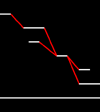
|
Chapter 12 A Metaphysical Grammar |
|
We have seen in previous chapters that
Metaphysics by Default allows for four different types of existential
passage. These types are:
Under Metaphysics by Default any passage
must be one of these four possible types.
A
"metaphysical grammar" appropriate to Metaphysics by Default is
printed in Figure 12.1 below:
|
|
In Figure 12.1 time is assumed as running from left to right.
Four events occur, ordered temporally as (1.) to (4.).
Also, the single non-event at bottom is noted as (5.). Here is the deciphered grammar:
The metaphysical grammar is simple.
Each passage type has been recorded only once. Moreover, the number of
participants in each passage has been kept to a bare minimum.
The metaphysical
grammar is also complete. Every passage type possible under Metaphysics by
Default finds its example in this figure. Additionally, the
"Methuselah" timeline illustrates the sole non-event condition — a
longevity which surpasses all recorded events.
Even when we
consider the figure as an abstract symbol, quite apart from any school of
philosophy, no alternative interpretation suggests itself. The lines, qua lines, sketch no representational figure; form no
equation; trace no physical or social process. They are as meaningless as
any random set of lines can be.
And this makes
the symbol well suited for use as a metaphysical grammar. A teacher might employ the symbol as a tool of pedagogy, or else as a
ready test of a student's understanding. In either case the student would
recognize the symbol just as the metaphysical grammar,
or else not at all. Regardless of the
student's language or cultural background, misinterpretation would be
unlikely.
I think the metaphysical grammar fulfills
some of the promise in al-Farabi's words. This unambiguous symbol maps out
all of the passage types implicit in the metaphysical philosophy. If I've set a
high enough standard for the philosophy, its symbol may satisfy.
If not — well, in that case al-Farabi stays upon our leisure.
next Chapter 13: Merger Probability |
|
Chapter 12 Endnotes |
|
[1] Walzer 282-83. |
Copyright © 1999
Wayne Stewart
Last update 4/19/11
